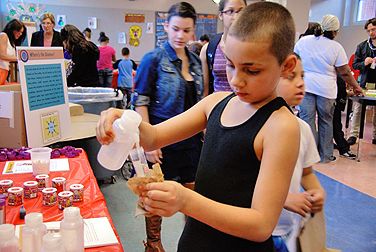News
Buffalo teachers look to reshape
science education

A student at the Native American Magnet School performs an experiment during the recent Science Fun Night at the school. Photo: BUFFALO PUBLIC SCHOOLS
-
 Print
Print -
 Comments
Comments
-
“As the global economy looks to 21st century STEM skills, our ISEP teachers also increase their knowledge, which will, in turn, allow them to better prepare our students for 21st century college and careers.”
Fifty-eight teachers from the Buffalo Public Schools have been selected to take part in the Interdisciplinary Science and Engineering Partnership (ISEP), a professional development program that encourages hands-on laboratory and field work in science classes.
The goal is to improve science learning by cultivating science classrooms where students are not passive observers, but curious, young investigators working on eye-opening projects.
Through ISEP, the teachers will immerse themselves in hands-on science this summer by conducting interdisciplinary research with local scientists or taking a teacher-preparation course emphasizing hands-on instruction and student scientific discourse.
Then, the teachers will bring what they learned back into their schools, engaging students in projects like building solar cells, testing water quality and analyzing cancer-cell DNA using gel electrophoresis. Partners including parents, corporate scientists and UB graduate students will help with activities in class and after school.
Joseph Gardella, John and Frances Larkin Professor of Chemistry at UB who coordinates ISEP, says the program is unique “because it not only provides professional development opportunities, but gives teachers a support network they can rely on to help carry out ideas.”
“We have 13 UB science and engineering PhD candidates working for about 20 hours a week and over 50 undergraduates in the schools providing wrap-around classroom and after-school support for implementation of hands-on science,” Gardella says.
ISEP is led by UB, Buffalo Public Schools, Buffalo State College and the Buffalo Museum of Science. The program, which was piloted at three schools over the past few years, expanded to include a total of 12 middle and high schools this year, thanks to a $9.8 million National Science Foundation grant.
This summer, 42 of the 58 ISEP teachers will conduct interdisciplinary research with a UB science, technology, engineering or mathematics (STEM) faculty member, or with a scientist at Hauptman-Woodward Medical Research Institute, Roswell Park Cancer Institute or Praxair Inc.
The other 16 teachers, along with a few in the research group, will take a course at Buffalo State College that engages them in hands-on science and engineering, and introduces enticing ways of presenting scientific information to K-12 classes.
“The ISEP program provides middle and high school science teachers with an opportunity to collaborate and develop advanced lessons focused on scientific skills and concepts,” says Kelly Baudo, supervisor of science education for Buffalo Public Schools. “These lessons, related to research topics and classroom science themes, are first delivered in the middle school science classes and then expanded upon at the high school level, allowing students the opportunity for ongoing analysis and investigation of scientific concepts. As the global economy looks to 21st century STEM skills, our ISEP teachers also increase their knowledge, which will, in turn, allow them to better prepare our students for 21st century college and careers.”
Ideally, through ISEP, students come to understand science not as sets of facts to memorize in individual subjects like biology or physics, but as a creative endeavor geared toward solving real-world problems bridging many disciplines.
Each school in the program is structuring science curricula around exciting, interdisciplinary topics, from bioinformatics and forensic science at East High School to physics and auto technology at Burgard High School.
In a high-needs urban district where students score below state averages in math and science, ISEP is yielding results at pilot schools.
At Native American Magnet (School 19), dozens of eighth graders have taken the ninth-grade-level New York State Regents living environment course since 2008. Nearly all have passed the associated exam.
Across town at the Math, Science and Technology Preparatory School (MST Prep), ISEP teachers and partners helped guide the design of state-of-the-art teaching laboratories as part of a major campus renovation. New facilities at the school, which held its grand reopening in May, include collegiate-style science labs and an aquatic ecology lab with eight fish tanks, seven terrariums and space for experiments.
Michelle Zimmerman, the lead ISEP teacher at the school, will be using probeware to test for ion-selective electrodes in zebra fish tanks at UB this summer. The experience will enable her to design a class project that asks students to monitor ions in a classroom tank and outdoor learning pond.
“I enjoy being involved with the ISEP program because it affords me the opportunity to experience the challenges that academia and employers face when receiving our students after high school so that I can help bridge the gap and better prepare students with the skill sets that they will need for the 21st century job market,” Zimmerman said.

Reader Comments